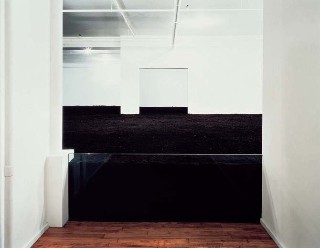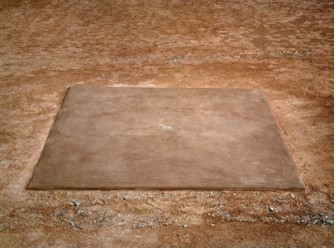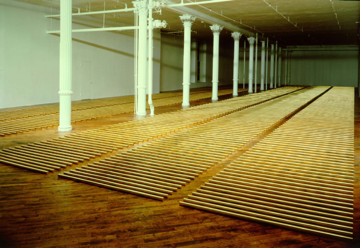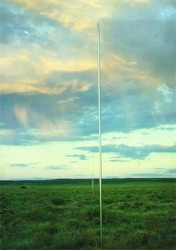Access /Desire:
Obstruction, Concealment, and Anticipation in the Site Specific Installations of Walter De Maria
Leigh-Ann Pahapill

The New York Earth Room (1977). Long-term installation at Dia Center for the Arts,
141 Wooster St., New York City. Photo: John Cliett. © Dia Art Foundation.
Desire unfolds the constitutive distance of the sensible;
by aspiring to the totality, it opens the depth of appearance.
Renaud Barbaras [1]
While climbing the narrow staircase up to Walter De Maria's New York Earth Room (1977), I was struck by the way the work pre-presented itself; I could both smell the loam and feel its humidity well before I rounded the top of the landing and turned down the narrow hallway to see the 250 cubic yards of earth installed in the gallery space. After having tripped through the sprawling Matthew Barney exhibit at Barbara Gladstone; and having been aurally ‘enchanted' by the cinematic lullabies of the Hiraki Sawa at James Cohen; and seduced by the scientific visuality of the club-like ambience of the Olafur Eliasson at Tanya Bonakdar I was primed for the immersive potential of installation art. Yet the New York Earth Room neither gestured to me, nor invited me into its space the way the other works had done; instead, it remained at a distance, always away from me. I was therefore denied access not simply because of the Plexiglas barrier and the gallery attendant, but by the very nature of the work itself. That the viewer had to remain in their own space and revere the Earth Room from a distance was reinforced by the mass of the piece, its staggering volume and height. This sense of reverential space and distance was repeated in De Maria's second Soho permanent installation, The Broken Kilometer (1979), where a low-slung series of columns tied together with cable keep the viewer at a distance from the perfectly ordered series of 500 solid brass rods arranged on the gallery floor.
As an artist working in installation, I found myself captivated by these two works, completely compelled both by De Maria's refusal to allow access and by how, quite paradoxically, the work transfixed me in a way none of the other works, despite equal efforts to physically and sensually engage me, had done. De Maria's nearly thirty-year-old installations arouse, engage, and stir with stillness and quiet – through what they don't allow and don't show but allow me to imagine. Much more than just an escape [2] into “the lush experience of the work” or a “withdrawal into the self, to a place of bodily sensation”,[3] De Maria's coupling of the interruption of physical immersion with his rigorous conflations of conceptual frameworks result in a dialectical tension. Not here-not there, De Maria's relational installation spaces require a double movement; away from the self (from sense perception toward logic) and back again, returning with the knowledge of difference garnered from this mental engagement.
Often overlooked in the case of De Maria, purposeful incompleteness is the key that prevents the work from closing down on itself and endlessly pointing toward the transcendent – a criticism directed at many of De Maria's 1960s and 1970s contemporaries. In her catalogue essay for De Maria's 1988 show in Stockholm, Jeanne Silverthorne raises this problem in relation to De Maria's oeuvre:
I disagree with this notion of the viewer as “irrevocably locked” – since the context of the viewer's gaze is a rich, sensual and immersive space. Despite the fact that De Maria restricts physical access, his appeal to the senses transports the viewer – through an exercise of physical imagination – into his space. Indeed, as Silverthorne points out, desire is at play in De Maria but not simply to bring to consciousness a will to power[5] as she argues. She later concludes with the claim that De Maria's work reflects the “human fantasy of omnipotence”[6] and that the viewer “must confront the outsized nature of their own belief in self-determination and conscious will, and the degree to which they themselves desire to control.”[7]
Instead, using a Hegelian model of desire as a progressive mediated unity (as opposed to a repressive sublimation toward immediate unity),[8] I would argue further that De Maria presents a dialectic of access and restriction to highlight that desire is a relational self-consciousness, albeit one that is never satisfied. Hegel's self-realization is characterized by not just one negative (the refusal of the subject in favor of the Other, as in his notion of sense certainty – or the problem of subjectivity) but by the second negative of the assimilation or appropriation of the Other.[9] Self-consciousness requires a limit in the ongoing mediation by the Other:
De Maria mirrors this double negative through his refusal to allow immediate apprehension of the object (by blocking, withholding, concealing and dissolving) while initiating a perceptual and subjective experience that is nonetheless denied full fruition. The in-between space that is illuminated in the movement of this double negative posits self-realization as the desire that is articulated in the flux between subject and object – between the ‘not here' of subjective experience and the ‘not there' experience of the object:
We become through our desire but our becoming always evades us, or we are our desire but we must always evade ourselves in order to self-actualize.
De Maria facilitates the evasion of subjective experience through concealment and effacement and in so doing we are reminded by our frustrated longing of “an originary incompleteness that exceeds everything that can satisfy it, that is renewed to the exact degree that it is fulfilled, and that is undoubtedly at the origin of need.”[12] We always want more – but more actually inhibits and spirals into pleasure rather than knowledge – a charge leveled at much contemporary installation art (that being, it descends into pure theatricality).[13]

Vertical Earth Kilometer (1977) Kassel, Germany. Photo: Nick Tenwiggenhorn. © Dia Center for the Arts
But not only does De Maria repeatedly limit sense experience, he also continually reasserts the failings of finite knowledge reminding us that despite our efforts to progress toward self-realization our desire to know is all that can ever be materialized. In many works, he strives to reveal our processes of knowledge as mere abstraction: the logic of measurement by which we purport to know the world is held up for scrutiny as one method of knowing (certain actuality) is contrasted with another.[14] The Vertical Earth Kilometer (1976), a one-kilometer long brass pole installed into the ground in Kassel, Germany that reveals only its top two inches, is an example of De Maria's strategy of concealment, along with its power to activate desire and the correspondent imaginative function that arises in this space. De Maria forces us to consider two things: How do we ‘know' a kilometer? And correspondingly, how do we conceive of that which is Other? Here De Maria asserts that we understand the Other only by abstract conception. His denial of the objectification of the Other (here nature) helps to re-situate his oeuvre in a postmodern moment. He denies the viewer this conception in order to thwart that objective inclination and show its insufficiency as a source of knowledge:
Through a dialectic of self-realization the Other emerges and vanishes, resisting conceptualization at every turn.
Yet, as discussed earlier, for every turning away, there is a correspondent revivification of desire. In his Vertical Earth Kilometer, De Maria's concealment serves to continually re-captivate. It is always escaping conceptualization and so speaks to our desire to see the hidden. Often expressed as curiosity, the desire to see the hidden is tantamount to the desire for knowledge of the transcendent:
This definition reveals the very nature of the activity of curiosity as a socially discouraged and blasphemous attempt at knowledge of the Other. It mirrors the need to limit subjective experience in the process of self-realization. Covetous, curiosity is rooted in desire but is tied to a condemnatory need for repression and underscores the limits of knowledge. De Maria's dematerialization, through concealment of the kilometer, points to the limits of the impulse to objectify – it can only translate the imponderable as “arbitrariness distances the numeration from rationality, empties it of content, and brings it closer to an incomprehensible, ungraspable totality”.[17] De Maria's concealment thus holds the deconstruction of logic (as numeration) in tension with the desire to know; this tension is necessarily irresolvable and requires that we constantly engage with the space between impulse and its satisfaction.

The Broken Kilometer (1979) Long-term installation at Dia Center for the Arts,
393 West Broadway, New York City. Photo: Jon Abbott. © Dia Art Foundation.
De Maria also conceals when he reveals. The Broken Kilometer (1979), described as the companion piece to the Vertical Earth Kilometer, seeks to explicitly describe the kilometer by breaking it up into 500 parts, each rod six feet-six inches in length arranged in rows of 100 bars each. Despite its insistent materiality, The Broken Kilometer remains elusive and intangible: the brass rods seem to dissolve as they fade off into the horizon of the gallery while their shimmering surface works to dissolve the gallery floor. The tension between the desire to objectify space and the endless retreat of the object serves both to elucidate the failings of rational systems as tools for describing the ineffable, as well as to highlight the perpetual desire for such knowledge:
The Broken Kilometer literally fragments and dissolves the categories of understanding that we use to know things in the world. De Maria's insistent ordering of the rods points to our ordering of the world as a way of trying to ‘know' it, all the while continually problematizing how we come to know by either using a conceptual apparatus or our sight.
Distrust of the realm of sense perception as a source of knowledge is described in Hegel in terms of a pre-perceptual moment as the problem of ‘sense certainty'. The instability of the space of now as a space that always escapes realization outside of simple subjectivity (because ‘now' slides with us through time) reveals the space of knowledge as a dialectical space of becoming that involves the desire to actively appropriate the Other:
Despite their failings, our efforts to conceptualize our surroundings are mediations necessary to the progress of self-realization. De Maria's dissolutions posit that seeing and believing are elements of simple consciousness that must be moved beyond, yet returned to with the progress afforded by distance.
This distance, as horizon, is both the location of and the wellspring of desire. A discussion of horizon will clarify my difficulties with Silverthorne's argument that the viewer is “irrevocably locked out” of spatial experience in The New York Earth Room. Despite his obstructions, dematerializations, and dissolutions, De Maria uses horizon in an explicitly incorporative way. That the horizon does not just retreat and dissolve but is also insistently materially present in The New York Earth Room and The Broken Kilometer serves as an articulation of the necessary dialectical engagement with the viewer. Continually reasserting itself and yet regressing, the horizon is the Other that must be mediated in the progress of self-realization:
That I cannot actually move to the horizon does not prevent my responding to the invocation of its presence. In fact, by his obstructions and dissolutions, De Maria has shown that perhaps the most profoundly spatial experience of the horizon may actually require the denial of my physical access and therefore invite my mind. In a leap toward the perception of self-realization we move beyond the simple consciousness of sense stimulus. I must move beyond ‘I' to become me and to see that ‘I see' is already a mediation.

The Lightning Field (1977) Quemado, New Mexico. Photo: John Cliett. © Dia Art Foundation.
As perhaps De Maria's most tangible challenge to solipsism,[21] The Lightning Field (1977), despite allowing physical access, ironically also frustrates sense experience in its posture of waiting. Although some level of experience is given to the viewer wandering amongst the 400 stainless steel poles installed in the American desert one mile by one kilometer, the completion required by the cooperation of nature (that is, an actual lightning strike) sets the stage for desire.[22] Access (as completion) is denied to the viewer, who must then imagine the engagement of the Other. In other words, I cannot even see (know) without my acknowledgement of the Other as “self-consciousness achieves its satisfaction only in another self-consciousness.”[23]
As such a de-objectification, The Lightning Field points away from itself and points to the space between earth and heaven, serving to articulate the space of desire as an active, perpetual and insatiable negotiation between the two poles:
Like the previous works discussed that implicate the viewer in a mental relation between the space of sense experience and the horizon as the Other, The Lightning Field points to the necessity of connection with nature as Other and that the desire for the transmission of knowledge of nature is implicated in self-realization.
Again and again, De Maria's de-objectifying strategies are juxtaposed with the deconstructions of conceptual systems. How we know space, as measured in mass and length, is recast as in terms of unknowing: form is made formless through concealment, fracture and is negated by collocation.[25] Deconstruction is employed by De Maria in order to de-throne objectivity whilst visualization and access are denied to retard the affirmations of sensation. Cleared of rational conceptuality, a new fullness emerges as relation:
By deconstructing how we know, De Maria insists on transcendence but a return is always ensured in his carefully constructed spaces as desire emerges and is fed by his obstructions.
Sense experience reveals only simple consciousness and so must be impeded or retarded. The emergence of self-realization requires a mental engagement with the Other. True immersion as a propositional attitude may thus require lack of access in order to overcome the problem of sense-certainty:
De Maria's ongoing challenge to this problem of conceptualization is what aids his continuing relevance to the postmodern moment.
As I have shown, his use of obstructions, dissolutions and concealments are evidence that De Maria does not simply point to the transcendent.[28] Rather, in his structuring and presentation of absence assisted by the deconstruction of conceptual strategies he continually reasserts, “truth defined as the objective, transcendental view of the world cannot be supported.”[29] This is also the task of the postmodern artist:
[1] Barbaras, Renaud. Desire and Distance: Introduction to a Phenomenology of Perception (Stanford: Stanford University Press, 2006), 125.
[2] De Oliveira, Nicolas et al. Installation Art in the New Millennium: The Empire of the Senses (New York: Thames and Hudson, 2004), 49. De Oliveira argues that the development of immersive strategies in installation is a response to the human desire to escape. Although he emphasizes a social interest in shared escape, calling some contemporary installation “…a focal point for the viewer's attention, as well as a meeting place” (De Oliveira, 52), De Oliveira stops at the subjective moment in Installation viewer strategy. See chapter on ‘Escape', 49 – 79.
[3] Ibid., 49.
[4] Silverthorne, Jeanne. Walter De Maria, September – December 1988 (Stockholm: Konsthall, 1988), unpaged.
[5] This is the basis of Silverthorne's analysis of De Maria – a Freudian interpretation curiously drawn out from her quote from Iris Murdoch (who is generally interpreted as a critic of Freud), see Turner, Jack. ‘Murdoch vs. Freud in A Severed Head and Other Novels', Literature and Psychology , vol. 36, no. 1-2, 1990, 122-34.
[6] Ibid. (Unpaged)
[7] Ibid. (Unpaged)
[8] I am using Clark Butler's formulation of the differences between Hegel and Freud despite the author's intention in the article to elucidate their similarities. I am more convinced, and as Butler indicates is most often the case, that Hegel's Absolute Idealism is opposite to Freud's Naturalism. Butler, Clark. ‘Hegel and Freud: A Comparison', Philosophy and Phenomenological Research , vol. 36, no. 4, 1976, 506 – 522.
[9] ‘The Self-knowing spirit knows not only itself but also the negative of itself, or its limit: to know one's limit is to know how to sacrifice oneself'. Hegel, G. W. F. Phenomenology of the Spirit , translated by A.V. Miller. (Oxford: Clarendon Press, 1977), 492.
[10] Singer, Peter. Hegel: A Very Short Introduction (New York: Oxford University Press, 1983), 76.
[11] Barbaras, 2006, 121.
[12] Ibid., 111.
[13] The move toward theatricality in installation is discussed (albeit uncritically) in De Oliveira et al as a “… new ‘immersive' installation [which] reflects desire for sensual pleasure. It provides a ‘total artwork' which envelops the viewer in a hermetic and narcissistic space. The location of the installation is in the realm of the imaginary, stimulated by the need for escape”, see De Oliveira et al, 2004, 4.
[14] For example, De Maria's Lightning Field (1977) is comprised of 400 polished stainless steel poles arranged in a grid measuring one mile by one kilometer.
[15] Geraci, Robert M. ‘Signaling Static: Artistic, Religious and Scientific Truths in a Relational Ontology' Zygon , vol. 40, no. 4, 2005, 10.
[16] Curiosity (n). The Oxford English Dictionary. 2 nd ed. 1989 . OED Online. Oxford University Press. .4 Apr. 2000 http://dictionary.oed.com.cgi/entry/50056021
[17] Celant, Germano. Walter De Maria: 1999 Milano 2000 (Milan: Fondazione Prada, 1999), 8.
[18] Ibid., 13.
[19] Harris, H. S. Hegel's Ladder I: The Pilgrimage of Reason (Indianapolis: Hackett Publishing Company, Inc., 1997), 320.
[20] Barbaras, 2006, 123.
[21] ‘Solipsism' used here as a reiteration of Hegel's concept of the limits of ‘sense-certainty' and the problem of subjectivity as a means to knowledge.
[22] ‘… Desire is the fact of the transcendental, or rather the transcendental as fact, the concrete form of its originary delay' see Barbaras, 2006, 126.
[23] Hegel as quoted in Beiser, Frederick (ed.) The Cambridge Companion to Hegel (Cambridge: Cambridge University Press, 1993), 69.
[24] Barbaras, 2006, 110.
[25] One mile is contrasted with one kilometer, the kilometer is concealed, mass is suspended in perfect tension with emptiness and so on.
[26] Celant, 1999, 12.
[27] Harris, 1997, 24
[28] As charged by Silverthorne, for example, ‘presentations are cathedral-like'. Silverthorne, 1998, (unpaged).
[29] Geraci, 2005, 954.
[30] This is Geraci's summation of Mark Taylor's thesis from his text Disfiguring: Art, Architecture, Religion (Chicago: Univ. of Chicago Press, 1992). Ibid., 964.
Leigh-Ann Pahapill is an artist working in installation and video. Her studio practice manifests her enduring interest in the exploration of the nature of aesthetic reflection. Leigh-Ann’s work can be viewed at www.adcreative.biz/leigh-ann-pahapill/index.html
©2006 Drain magazine, www.drainmag.com, all rights reserved